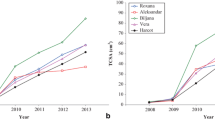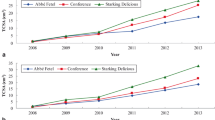Abstract
This paper examines the effect of ploughing depths (A — 60 cm, B — 45 cm and C — 30 cm) on the growth and yield ofHeracleum candicans Wall (Apiaceae), a threatened medicinal herb of the Himalayan region. This less-explored plant is being suggested as a potential crop for the mountain agriculture. The study was carried out in an orchard in Himachal Pradesh, India at 2500 m altitude, for two successive growth years. During the first year, all plants remained in juvenile state; in the second year, nearly 65 % plants produced flowers only under 60 cm ploughing depth. Among its morphological traits, plant height, collar diameter and aboveground fresh weight were found to be strongly correlated (P<0.01) with the belowground biomass during the first year (r=0.968, 0.925 and 0.973, respectively) and during the second year (r=0.945, 0.928 and 0.775, respectively). Increase in the ploughing depth was significantly correlated (P<0.01) with all growth parameters, including the belowground dry weight, marketable portion of the produce. The belowground biomass (commercial yield; 16.28 Qt/hec) at depth A was about 2.6 and 4.7 times higher than those recorded at depths B and C, respectively. The results clearly justify the importance of deep ploughing and this paper strongly recommends it for economically sustainable cropping.
Similar content being viewed by others
References
Agarwal, P.K., Karihallo, J.L. Ahmed, S.M.M. and Gupta, P.C. 1973. Predicting germinability in maize, wheat and paddy on the basis of tetrazolium test.Seed Research 1: 83–84
Anonymous. 1998.Conservation assessment and management plant workshop-briefing book. FRLHT, Bangalore, India
Badola, H.K. and Pal, M. 2002. Endangered medicinal plants in Himachal Pradesh.Current Science 83: 797–798
Badola, H.K. and Aitken, S. 2003. The Himalayas of India: A treasury of medicinal plants under siege.Biodrverstiy 4: 3–13
Badola, H.K. and Butola, J.S. 2003. Cultivation Production Trials ofHeracleum candicans, a Threatened High Value Medicinal Herb, in Himachal Himalaya.Umbellifereae Improvement Newsletter, USA.13: 6–10
BCIL. 1996.Sectoral study of Indian Medicinal Plants- status, perspective and strategy for growth. Biotech Consortium India Ltd., New Delhi.
Bhat, B.K. and Kaul, M.K. 1979. Prospectus ofHeracleum candicans Wall, cultivation in Kashmir.Herba Hungarica 18: 59–62
Bradu, B.L. and Atal, C.K. 1973. Introduction ofAmmi majus L. Cultivation in Himachal Pradesh. Proc. Ist workshop on Medicinal and Aromatic Plants, Bangalore.
Brady, N.C. 1984. The Nature and Properties of Soils. Mcmillan Publ. Co., New York, USA. Pp 750
Butola, J.S. and Badola, H.K. 2004a. Seed germination improvement using chemicals inHeracleum candicans Wall, a threatened medicinal herb of Himalaya.Indian Forester 130 (5): 565–572
Butola, J.S. and Badola, H.K. 2004b. Effect of pre-sowing treatment on seed germination and seedling vigour inAngelica glauca, a threatened medicinal herb.Current Science 87: 796–799
Chopra, R.N., Chopra, I.C. and Verma, B.S. 1969.Supplement to glossary of Indian medicinal plants. Council for scientific and Industrial Research, New Delhi.
Gaur, R.D. 1999.Flora of the district Garhwal, north- west Himalaya (with ethnobotanical notes). Trans Media, Srinagar (Garhwal), India.
Haamen, M., Reithel, J, Jones, K., Clapp, C and Andrade, K. 2003. The response ofHeracleum sphondylium (Apiaceae) and its herbivores to simulated herbivory and soil nutrient augmentation. Undergr. Res. in Behaviour, Ecol. and Evol.1(1): 1–8; 2 (online) url: http//www.urbee.org/vol1/iss1/art2.
Joshi, M. and Dhar, U. 2003. Effect of various presowing treatments on seed germination ofHeracleum candicans Wall. ex DC.: a high value medicinal plant.Seed Science & Technology 31: 737–743
Joshi, M., Manjkhola, S. and Dhar, U. 2004. Developing propagation techniques for conservation ofHeracleum candicans — an endangered medicinal plant of the Himalayan region.Journal of Horticulture & Biotechnology 79: 953–959
Kaul, M.K. 1989.Himalayan Heracleum Linn (Hogweed)-A Review. Regional Research Lab., CSIR, Jammu-Tawi.
Larcher, W. 1991.Physiological Plant Ecology. Springer-Verlag, Berlin.
Mehra, P.N., Bhatnagar, J.K. and Handa, S.S. 1969. Researches in pharmaconosy in India. Bull (N.S.) Punjab Uni., Chandigarh20: 261–337
Snedecor, G.W. and Cochran, W.G. 1967.Statistical methods. Oxford and IBH Publishing, New Delhi, India.
Ved, D. K., Kinhal, G.A., Ravikumar, K.,et al. 2003. CAMP Report: Conservation Assessment and Management Prioritisation for the Medicinal Plants of Jammu & Kasmir, Himachal Pradesh & Uttaranchal, Workshop, Shimla, Himachal Pradesh. FRLHT, Bangalore, India.
Author information
Authors and Affiliations
Corresponding author
Rights and permissions
About this article
Cite this article
Badola, H.K., Butola, J.S. Effect of ploughing depth on the growth and yield ofHeracleum candicans: a threatened medicinal herb and a less-explored potential crop of the Himalayan region. J. Mt. Sci. 2, 173–180 (2005). https://doi.org/10.1007/BF02918333
Received:
Accepted:
Issue Date:
DOI: https://doi.org/10.1007/BF02918333




